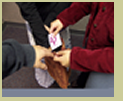|
|
|
||
 |
MONEY LEIS A visitor to a graduation ceremony held at any of the universities in Southern California would not have to look very far to see students adorned in leis, or garlands fashioned in traditional Hawaiian style, in addition to the standard caps and gowns. A number of these graduation leis are made entirely out of genuine dollar bills, rather than the flowers or leaves one might expect. more... | |
 |
IMAM
ZAMIN One
does not unlearn all that one has been taught once removed from the soil
one has bloomed in. So it is also true that culture will be carried and
spread from parents to children and from country to country. This is the
case with the use of money, specifically coins, in a South Asian Muslim
tradition called Imam Zamin. In this cultural practice, coins are wrapped
in a cloth and tied around the arm for good luck and safety during travel,
for example. When the person returns, a form of charity is expected to
be given or a dessert is to be bought by the bearers of the wrapped coins
in thanks for a safe journey. more... |
|
 |
GHOST
MONEY There’s always a
particular smell of burning incense when one walks through the gates of
a Buddhist temple. The smoke looms around in a mist-like form. The air is
difficult to breathe and some of the people’s eyes burn from the ashes
around. The faithful continue to add more to the already huge amount of
incense of all shapes and sizes—the little flames on the top of the
incense glows through the misty smoke. Before the incense lay the deities,
to whom some ask for divine guidance for their cause. Today, a girl was
burning something else in the temple. I looked down at what she was burning—some
form of paper money? more... |
|
 |
JIAO
ZI DUMPLINGS Jiao zi are made during the New Year to resemble
the gold and silver ingots. People in Henan and Sanxi provinces enjoyed
boiling dumplings with noodles and serving them together. The term jiao
zi has multiple meanings; one of the meanings means “midnight or the
end and the beginning of time.” This is why the jiao zi are made the
midnight of the last day of the passing lunar year. Rich families in ancient
times added gold, silver, and other precious stones to their dumplings.
Getting one of these dumplings was considered good luck. Later, people started
adding coins to the dumplings. more... |
|
 |
MICHINK
Armenians practice something called “Michink” or “Micheng”
which translates to “mid-Lent.” Very little research has been
done on this practice. Michink is a celebration during the middle of Lent,
to encourage people to persevere until the end of that season. During
this celebration, women insert a coin into a pastry, and whoever receives
the slice with the coin will receive good luck. There are historical,
cultural, and monetary aspects to this tradition. Through in-depth research,
interviews, and analysis, we made many discoveries about this tradition
called “Michink.” more... |
|
 |
FENG
SHUI COINS Feng Shui coins are used in general for attracting
wealth and prosperity, depending on which school of feng shui you follow.
Coins are arranged in sets of three, tied together with a red ribbon, symbolizing
the unity of man, earth, and heaven called the Tien-di-Ren. The coin itself
has a square in the middle and 4 different Chinese symbols around it. The
square represents the energy of the earth while the roundness of the coin
represents the energy of heaven. When the ribbon is tied in different ways
it can represent various types of luck and can interpret the incoming Chi
in different ways. more... |
|
 |
HINDUISM
AND MONEY In Hinduism, the celebration of the New Year (Diwali)
and parts of the wedding ceremony demonstrate non-monetary uses of money.
The practice of praying for business-related items, gambling on Diwali,
worshipping coins, and the story of the goddess of wealth (Lakshmi) demonstrate
the different ways money is viewed in the diverse strands of Hinduism
we find in Southern California. The idea of praying to gods and goddesses
in the hopes of bringing wealth to a family on Diwali is balanced by the
idea that without knowledge the wealth is meaningless. While money is
necessary to live, knowledge is necessary to sustain life. more... |
|
 |
TANDAS
The tanda is a form of rotating credit association and a monetary practice
that we, as Chicanos, have grown up knowing but never really understood
in any depth, except that our parents or other relatives participated in
them. That is why we have chosen to research the tanda, which is rooted
deeply in the Mexican and Latin American culture and has evolved into a
common practice within Mexican-American and Latino-American enclaves in
southern California. more... |
|
 |
CH'AN CHU Ch'an Chu is like the relative who is in every family picture but whose name no one knows. He is the good luck charm many Chinese-Americans use without knowing his name or, for that matter, where he came from. The three-legged frog that has taken the modern form of a statuette sits quietly behind the counter at many Asian owned stores in Southern California. When asked about their tadpole treasure keepers, many just shrug and answer, "Money, good luck." more... | |